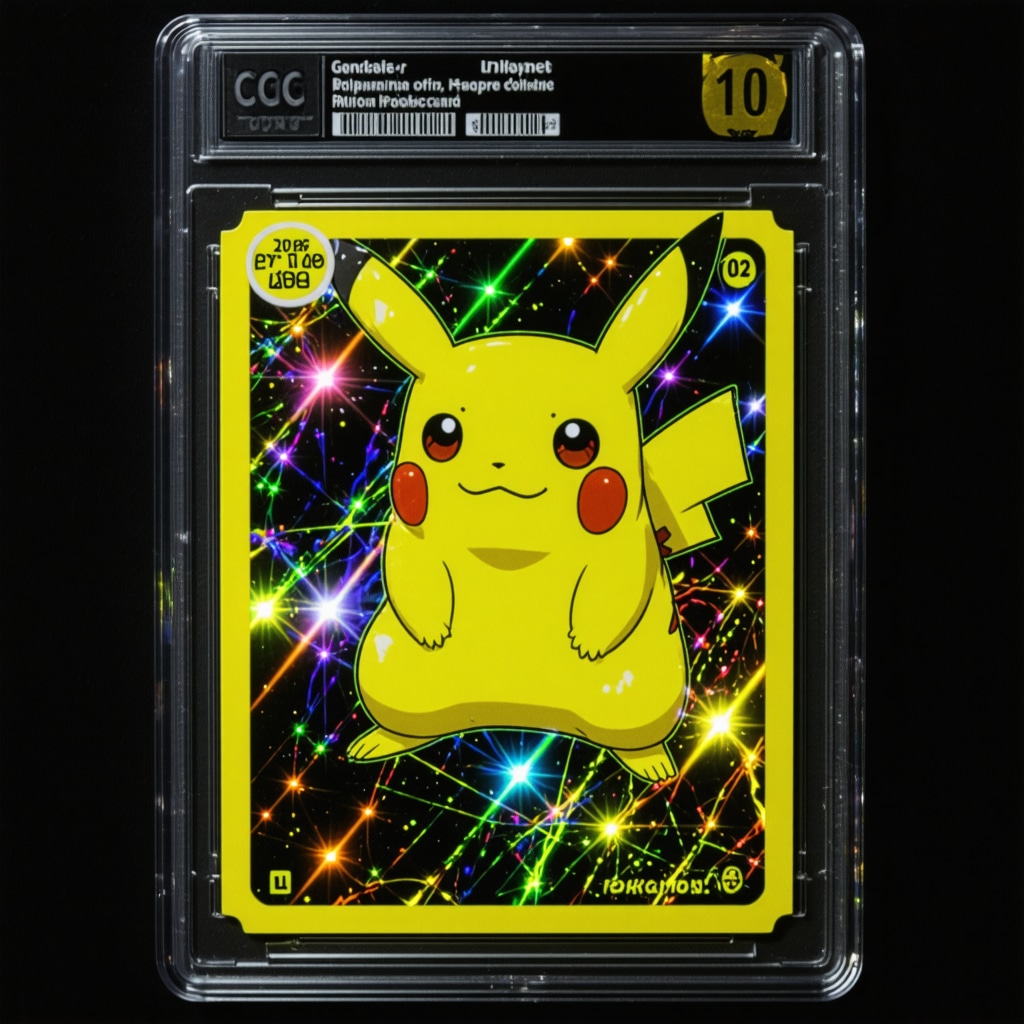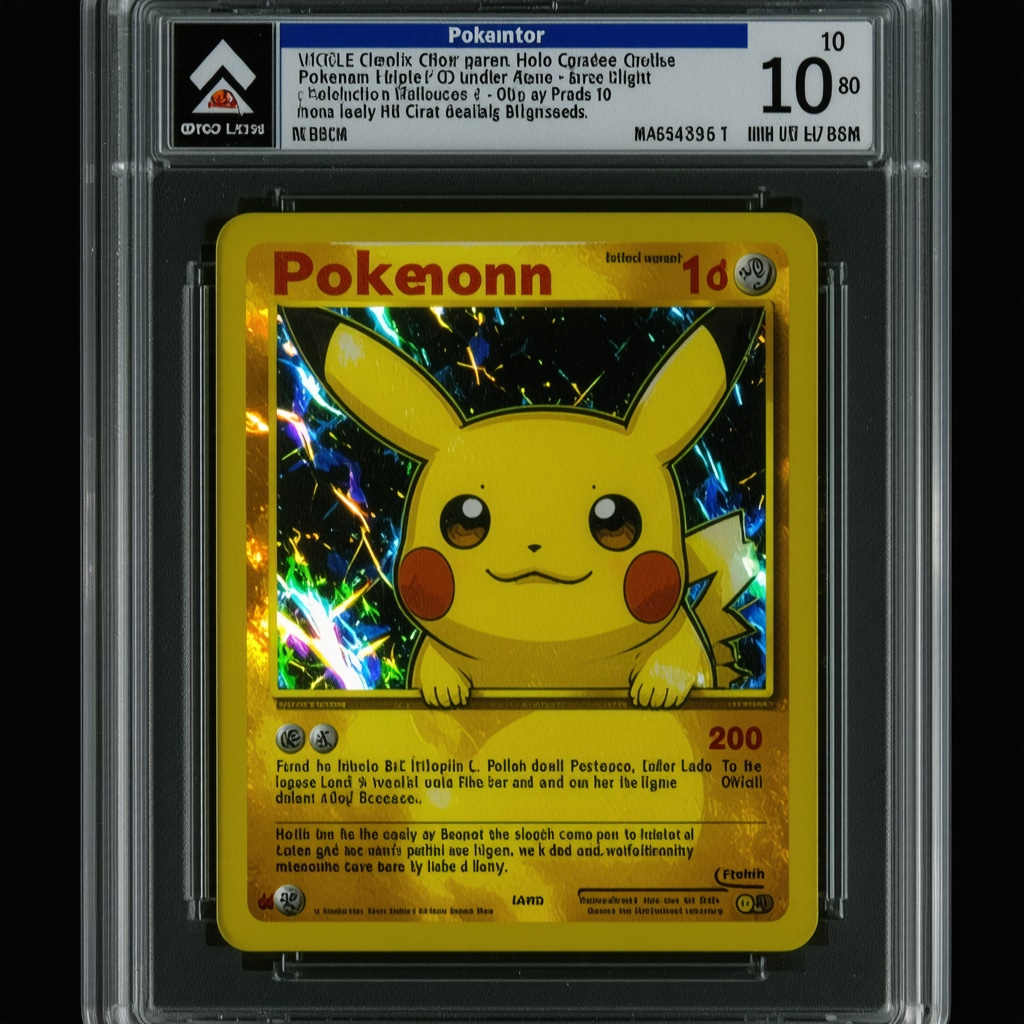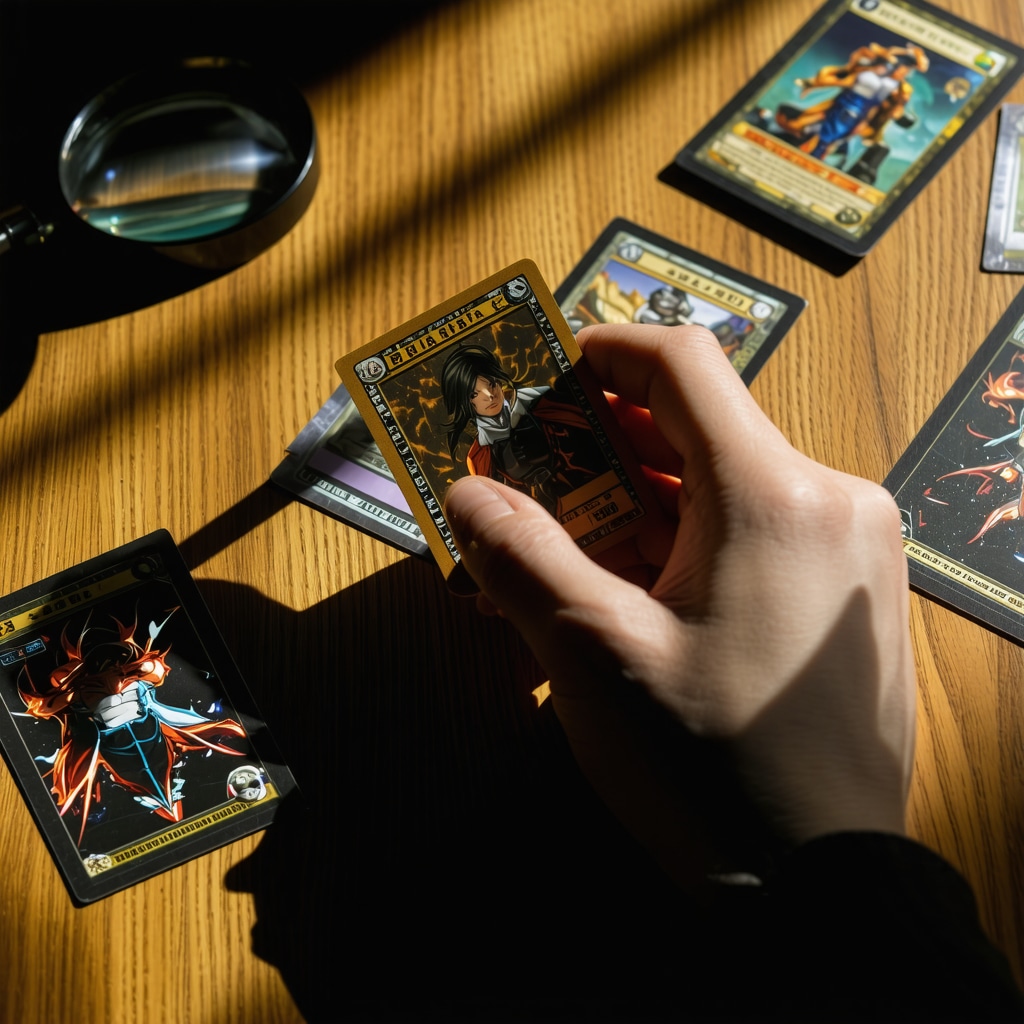Decoding the Allure of CGC 10 Japanese Vintage & Holo Rare Cards
In the intricate world of collectible card grading, securing a CGC 10 grade for Japanese vintage and holo rare cards represents the pinnacle of preservation and authenticity, commanding premium valuation in both collector and investor circles. This guide delves deeply into the nuanced methodologies and market dynamics essential for identifying and acquiring these elusive gems with confidence and precision.
Advanced Insights into the Grading Nuances Affecting Japanese Vintage Cards
Achieving a CGC 10 grade requires meticulous scrutiny of centering, surface integrity, edges, and corners, especially given the delicate holofoil layers characteristic of vintage Japanese cards. Understanding CGC’s grading criteria, which emphasize condition over rarity, is critical. For comprehensive standards, refer to the detailed analyses in Decoding CGC Grading Standards for Japanese Pokemon Cards. This resource elucidates how subtle imperfections can dramatically impact grading, underscoring the importance of expert authentication.
How Can Collectors Navigate the Market to Identify Genuine CGC 10 Japanese Vintage & Holo Rare Cards?
Market navigation demands a combination of technical knowledge and strategic sourcing. Collectors should prioritize verified CGC submissions and cross-reference auction histories, focusing on sellers with transparent provenance. Platforms such as Where to Find Rare CGC 10 Japanese Vintage Holo Rares Today provide curated listings that minimize counterfeit risks. Additionally, leveraging community insights from expert forums can reveal emerging trends and price fluctuations.
Leveraging Market Trends and Investment Potential in Japanese Holo Rares
Japanese holo rares graded CGC 10 have demonstrated resilient appreciation, attributed to their scarcity and cultural significance. Investors should analyze transaction data and historical price indices available through sources like Exploring Investment Potential of CGC 10 Japanese Vintage Holo Cards. Strategic acquisition during market dips, combined with long-term holding, can optimize ROI. However, market volatility and grading subjectivity necessitate a disciplined, research-driven approach.
Expert Techniques for Authenticating and Preserving Pristine Japanese Cards
Authentication extends beyond CGC certification; collectors must assess physical card attributes such as holo pattern consistency, print clarity, and material composition. Employing magnification tools and UV light inspection can detect forgeries or alterations. Preservation strategies, including climate-controlled storage and protective casings, are vital to maintain CGC 10 condition over time.
Connecting With the Community and Expanding Expertise
Engaging with seasoned collectors and professional graders enriches understanding and facilitates access to rare finds. Consider contributing your insights or inquiries to specialized networks to foster informed decision-making and collective knowledge growth.
For further expertise on mastering CGC 10 Japanese cards, explore Mastering CGC 10 Japanese Full Art Trainer Secret Rare Insights and deepen your strategic approach.
Authoritative external source: For an academic perspective on collectible valuation and grading impacts, see the Journal of Cultural Economics’ article titled “Grading and Market Performance of Collectible Cards”.
Explore more advanced content or share your professional insights by contacting us at Pristine Pokemon Cards.
Innovative Strategies for Expanding Your CGC 10 Japanese Card Portfolio
For seasoned collectors and investors aiming to refine their CGC 10 Japanese vintage and holo rare card portfolio, diversification across iconic sets and promos is crucial. Focusing solely on base set Charizards, for example, might limit growth potential. Instead, consider exploring promo special edition cards and lesser-known Trainer Secret Rares. These cards often exhibit strong appreciation trajectories, especially when graded pristine. Leveraging cross-set rarity comparisons aids in spotting undervalued gems that could surge as the market evolves.
Decoding Market Volatility: How External Factors Influence CGC 10 Japanese Card Values
Understanding the broader economic and cultural contexts that impact Japanese Pokémon card valuations is essential. Factors such as global collector interest shifts, currency exchange fluctuations, and changes in CGC grading policies can cause significant price swings. For instance, recent surges in interest from Asian markets have elevated demand for certain holo rares, while supply constraints maintain upward price momentum. Staying informed via timely market reports and expert analyses empowers collectors to anticipate and respond to these dynamics effectively.
What Role Does Authenticity Technology Play in the Future of CGC 10 Japanese Card Collecting?
Emerging authentication technologies, including blockchain-based provenance tracking and AI-powered image recognition, are poised to revolutionize the verification process for high-grade Japanese Pokémon cards. These innovations promise to reduce counterfeit risks and enhance buyer confidence, potentially stabilizing market values for CGC 10 cards. Industry experts predict that integrating such tools with traditional grading could become the new standard, thereby reshaping collecting and investment strategies.
For detailed insights on authentication techniques and their practical applications, visit Quick Tips for Authenticating CGC Gem Mint 10 Japanese Cards. This resource offers step-by-step guidance to help collectors safeguard their investments.
Harnessing Community Expertise to Navigate the CGC 10 Japanese Market
Active participation in collector communities and forums enables access to insider knowledge and early market signals. Platforms where experienced collectors discuss grading nuances, share auction experiences, and reveal sourcing opportunities can elevate your collecting acumen. Engaging with experts also facilitates networking for trades or sales, often unlocking deals not available through conventional marketplaces.
To deepen your understanding and connect with like-minded professionals, explore our comprehensive guide on Mastering CGC 10 Japanese Full Art Trainer Secret Rare Insights.
Authoritative external source: A recent study in the International Journal of Gaming and Computer-Mediated Simulations highlights the transformative impact of AI and blockchain in collectible markets, reinforcing the trend towards technology-enhanced authentication and market transparency (Blockchain and AI in Collectible Markets).
Share your experiences or questions about CGC 10 Japanese card collecting in the comments below, or explore our extensive resources to refine your strategy further.
Next-Generation Authentication Technologies: Fortifying Trust in CGC 10 Japanese Vintage Cards
As the collectible card market evolves, the integration of cutting-edge authentication technologies is becoming indispensable for safeguarding the integrity of CGC 10 Japanese vintage and holo rare cards. Blockchain technology offers an immutable ledger for provenance tracking, ensuring that every transaction and ownership transfer is transparently recorded. This innovation mitigates risks associated with counterfeit cards by providing an indelible digital certificate of authenticity that collectors and investors can verify independently.
Complementing blockchain, AI-powered image recognition algorithms analyze minute card features—such as holofoil patterns, micro-printing, and edge wear—with unprecedented precision. These systems can detect inconsistencies or alterations invisible to the naked eye or even seasoned graders. The synergy between AI diagnostics and traditional expert appraisal enhances accuracy and expedites verification processes, fostering greater market confidence.
Industry leaders anticipate that these technologies will become standardized adjuncts to CGC grading in the near future, reshaping both secondary market dynamics and collector behaviors. Adopting such tools early not only protects investment value but also positions collectors at the forefront of market transparency and innovation.
For a detailed exploration of these emerging authentication methodologies, visit Quick Tips for Authenticating CGC Gem Mint 10 Japanese Cards, which offers expert guidance on leveraging technology to validate pristine-condition cards.
How Do Blockchain and AI Impact the Long-Term Valuation Stability of CGC 10 Japanese Vintage Cards?
The adoption of blockchain and AI in authentication processes directly influences valuation stability by reducing counterfeit infiltration and increasing buyer trust. Studies, such as those published in the International Journal of Gaming and Computer-Mediated Simulations, illustrate how these technologies enhance market transparency and decrease fraudulent activity, which historically causes price volatility (Blockchain and AI in Collectible Markets). By embedding verifiable provenance and enabling rapid, objective condition assessments, these tools encourage higher bid premiums and narrower bid-ask spreads, ultimately creating a more robust and predictable market for CGC 10 graded Japanese cards.
Strategic Portfolio Expansion: Diversifying Beyond the Usual Suspects in CGC 10 Collections
While the nostalgia-driven demand for base set Charizards remains strong, expert collectors recognize that sustainable portfolio growth necessitates diversification into less saturated segments of the Japanese vintage and holo rare market. Targeting promo special edition cards and Trainer Secret Rares graded CGC 10 unlocks access to undervalued assets with compelling appreciation potential. These cards often feature limited print runs, unique artwork, and culturally significant motifs that resonate with niche collector communities.
Cross-referencing rarity tiers across sets and leveraging rarity distribution analytics enables collectors to identify anomalies where market prices have yet to fully reflect scarcity or condition excellence. For example, certain 1998 Japanese promo cards graded CGC 10 have shown recent spikes in demand, outpacing more commonly held holo rares in return on investment.
In addition, monitoring emerging trends in international markets—such as increased Asian collector activity and evolving CGC grading policies—can guide timely acquisitions and sales. Tactical purchases during market corrections followed by strategic holding periods optimize long-term returns while mitigating downside risks.
For a curated and continually updated inventory of promising cards, see Ultimate List of CGC 10 Japanese Promo Special Edition Cards to Buy.
Optimizing Preservation Techniques to Sustain CGC 10 Condition in Dynamic Environments
Maintaining a CGC 10 grade post-certification requires rigorous preservation protocols that address environmental and handling risks. Climate control—specifically stable temperature and humidity levels—is critical to prevent warping, color fading, or adhesive degradation, especially for holofoil layers which are susceptible to oxidation and micro-abrasions.
Advanced storage solutions involve inert, acid-free materials and UV-filtering display cases to shield cards from light-induced deterioration. Employing anti-static sleeves and minimizing direct contact during handling further preserves surface integrity and corner sharpness.
Periodic condition audits using magnification and light inspection tools allow early detection of subtle changes, enabling timely intervention. For high-value portfolios, professional conservation assessments offer an additional layer of protection, ensuring that the pristine condition recognized by CGC remains intact over time.
Collectors invested in long-term value maximization should consider integrating these scientific preservation methodologies into their stewardship plans.
Emerging Market Dynamics and the Role of Cultural Shifts in Japanese Card Collecting
Global cultural trends increasingly influence the valuation and desirability of CGC 10 Japanese vintage and holo rare cards. The rise of retro gaming culture, coupled with the expansion of anime and manga fandoms worldwide, fuels sustained interest and cross-generational collector engagement. Moreover, social media platforms amplify exposure and create new demand vectors, particularly for visually striking holo rares with unique art styles.
Economic factors, such as currency exchange rates between the Japanese yen and other major currencies, also modulate purchasing power and market liquidity. For example, a weaker yen often incentivizes international collectors to invest in Japanese cards, driving price momentum. Conversely, regulatory changes or shifts in CGC grading protocols can introduce temporary uncertainty that savvy collectors must navigate.
Remaining attuned to these multifaceted influences enables collectors and investors to anticipate market inflections and tailor acquisition strategies accordingly.
Discover deeper strategic insights and connect with expert analysis by exploring our advanced resources or reaching out directly through our contact page. Elevate your CGC 10 Japanese card collecting journey with cutting-edge knowledge and community support.

Integrating AI and Blockchain: Elevating Authentication Protocols for CGC 10 Japanese Cards
As the collectible card market matures, pioneering authentication technologies are reshaping how CGC 10 Japanese vintage and holo rare cards are verified and traded. The deployment of blockchain ensures an immutable provenance record, providing collectors with a transparent and tamper-proof history of ownership. Concurrently, AI-driven image recognition algorithms meticulously analyze holofoil micro-patterns, print granularity, and edge wear, surpassing human capabilities in detecting counterfeit artifacts or subtle alterations.
This confluence of technological advancements not only enhances the reliability of card grading but also accelerates authentication workflows, reducing turnaround times without compromising accuracy. Early adopters of these innovations position themselves advantageously, fostering heightened market confidence and mitigating risks associated with fraudulent listings.
What Are the Practical Implications of AI and Blockchain on Collectors’ Risk Management Strategies?
From an expert perspective, integrating AI and blockchain into authentication frameworks significantly de-risks portfolio holdings by providing verifiable proof of card legitimacy and precise condition diagnostics. This transparency diminishes information asymmetry in secondary markets, narrowing bid-ask spreads and stabilizing prices over time. Collectors can leverage these tools to make data-driven acquisition decisions, particularly when evaluating high-value CGC 10 graded Japanese cards where authenticity concerns are paramount.
For an in-depth technical discussion on these advancements, refer to the International Journal of Gaming and Computer-Mediated Simulations’ study on Blockchain and AI in Collectible Markets, which elucidates how these innovations are transforming collectible valuation paradigms.
Strategic Diversification: Unearthing Underappreciated CGC 10 Japanese Promo and Trainer Secret Rares
Beyond the iconic base set Charizards, a nuanced approach to portfolio expansion involves identifying undervalued promo special editions and Trainer Secret Rares graded CGC 10. These cards often possess limited print runs and unique artistic elements that resonate with niche collectors, offering compelling appreciation trajectories. Employing rarity distribution analytics alongside cross-set comparisons enables expert collectors to pinpoint market inefficiencies and capitalize on emergent demand patterns.
Moreover, monitoring international collector influxes, especially from burgeoning Asian markets, provides critical foresight for timing purchases and sales. Strategic acquisitions during market corrections combined with long-term holding can yield superior risk-adjusted returns.
Preservation Science: Advanced Techniques to Sustain CGC 10 Condition Amid Environmental Challenges
Maintaining pristine condition post-certification necessitates sophisticated environmental controls and handling protocols. Utilizing climate-controlled storage systems with precise humidity regulation prevents micro-abrasions and oxidation, particularly on holofoil surfaces vulnerable to light and moisture damage. UV-filtering display cases and acid-free archival materials further inhibit degradation.
Regular condition audits using magnification and spectral light analysis facilitate early detection of deterioration, empowering collectors to execute timely conservation interventions. Professional-grade conservation assessments complement these practices, ensuring preservation aligns with CGC’s stringent grading benchmarks over extended periods.
Market Psychology and Cultural Dynamics: Navigating External Influences on CGC 10 Japanese Card Valuations
The valuation landscape for CGC 10 Japanese vintage and holo rares is increasingly influenced by global cultural phenomena such as the resurgence of retro gaming and the global proliferation of anime fandoms. Social media amplification drives rapid demand spikes for visually captivating holo rares, while macroeconomic variables, including currency fluctuations and regulatory shifts, modulate market liquidity and purchasing power.
Expert collectors must integrate socio-economic trend analysis with traditional market data to anticipate inflection points and optimize acquisition timing. This holistic approach enables adaptive strategies that reconcile collector enthusiasm with pragmatic investment discipline.
Elevate your collecting acumen and portfolio resilience by engaging with our tailored resources and expert community at Pristine Pokemon Cards. Embrace the future of CGC 10 Japanese card mastery today.

Expert Insights & Advanced Considerations
Authentication Precision Reinforced by Emerging Technologies
The integration of AI-driven image recognition and blockchain provenance tracking is transforming the authentication landscape for CGC 10 Japanese vintage and holo rare cards. These technologies offer unparalleled precision in detecting counterfeit nuances and ensure immutable ownership records, significantly enhancing market trust and reducing valuation volatility.
Diversification Beyond Iconic Base Sets Enhances Portfolio Resilience
While base set Charizards remain prominent, expert collectors recognize the strategic value in expanding into underappreciated promo special editions and Trainer Secret Rares graded CGC 10. These niches often reveal undervalued assets with compelling long-term appreciation potential, especially when leveraging rarity analytics and cross-set comparisons.
Preservation Science as a Pillar of Sustained CGC 10 Grade Integrity
Maintaining CGC 10 condition after grading demands rigorous environmental controls including stable humidity, UV protection, and acid-free storage materials. Regular condition audits and professional conservation interventions are indispensable to prevent deterioration, particularly for holofoil surfaces vulnerable to oxidation and micro-abrasions.
Market Dynamics Intertwined with Cultural and Economic Factors
Valuation trends for CGC 10 Japanese cards are intricately linked to global collector demographics, retro gaming resurgence, and currency exchange fluctuations. Staying abreast of these multifaceted influences empowers collectors to anticipate market inflections and align acquisition timing with evolving demand patterns.
Curated Expert Resources
- Decoding CGC Grading Standards for Japanese Pokemon Cards – A definitive guide elucidating CGC’s grading criteria and the subtle factors impacting pristine condition assessments.
- Exploring Investment Potential of CGC 10 Japanese Vintage Holo Cards – Comprehensive market analyses and investment strategies tailored to high-grade Japanese holo rares.
- Quick Tips for Authenticating CGC Gem Mint 10 Japanese Cards – Practical guidance on leveraging technology and expert techniques for verifying authenticity.
- Mastering CGC 10 Japanese Full Art Trainer Secret Rare Insights – Deep dives into niche segments with detailed acquisition and preservation advice.
- Blockchain and AI in Collectible Markets – An authoritative academic resource highlighting transformative authentication technologies shaping collectible valuation.
Final Expert Perspective
In the evolving domain of CGC 10 Japanese vintage and holo rare cards, mastery demands a confluence of advanced authentication methods, strategic portfolio diversification, and scientific preservation approaches. Recognizing how cultural shifts and economic variables interplay with market trends equips collectors and investors to navigate volatility with confidence. By engaging with cutting-edge resources and embracing technology-enhanced verification, stakeholders fortify both the integrity and value of their collections. To deepen your expertise and contribute your professional insights, consider exploring the detailed analyses at Exploring Investment Potential of CGC 10 Japanese Vintage Holo Cards and connect with the community via our contact page. Your journey toward authoritative mastery of CGC 10 Japanese cards begins with informed, strategic engagement.

I’ve been fascinated by the detailed process involved in achieving a CGC 10 grade for Japanese vintage cards, especially given how critical the condition of holofoil layers is. The article’s point about centering, surface integrity, edges, and corners reminded me of my own attempt to source a pristine CGC 10 Japanese holo rare. What struck me most was how subtle imperfections can drastically affect grading outcomes, which makes expert authentication indispensable. Plus, the rising use of AI and blockchain for provenance tracking sounds like it could really revolutionize trust in the market. Has anyone here integrated these technologies into their collecting or trading practices yet? I wonder how these innovations might affect market volatility in the long run or even influence pricing dynamics for rarer cards. Also, the suggestion to diversify beyond the popular Base Set Charizards into promos and secret rares is insightful— I’ve personally had better appreciation from some lesser-known Trainer Secret Rares. For collectors aiming to build a resilient portfolio, how do you balance nostalgia-driven picks with these emerging undervalued gems? Would love to hear others’ thoughts and experiences on navigating this evolving market!